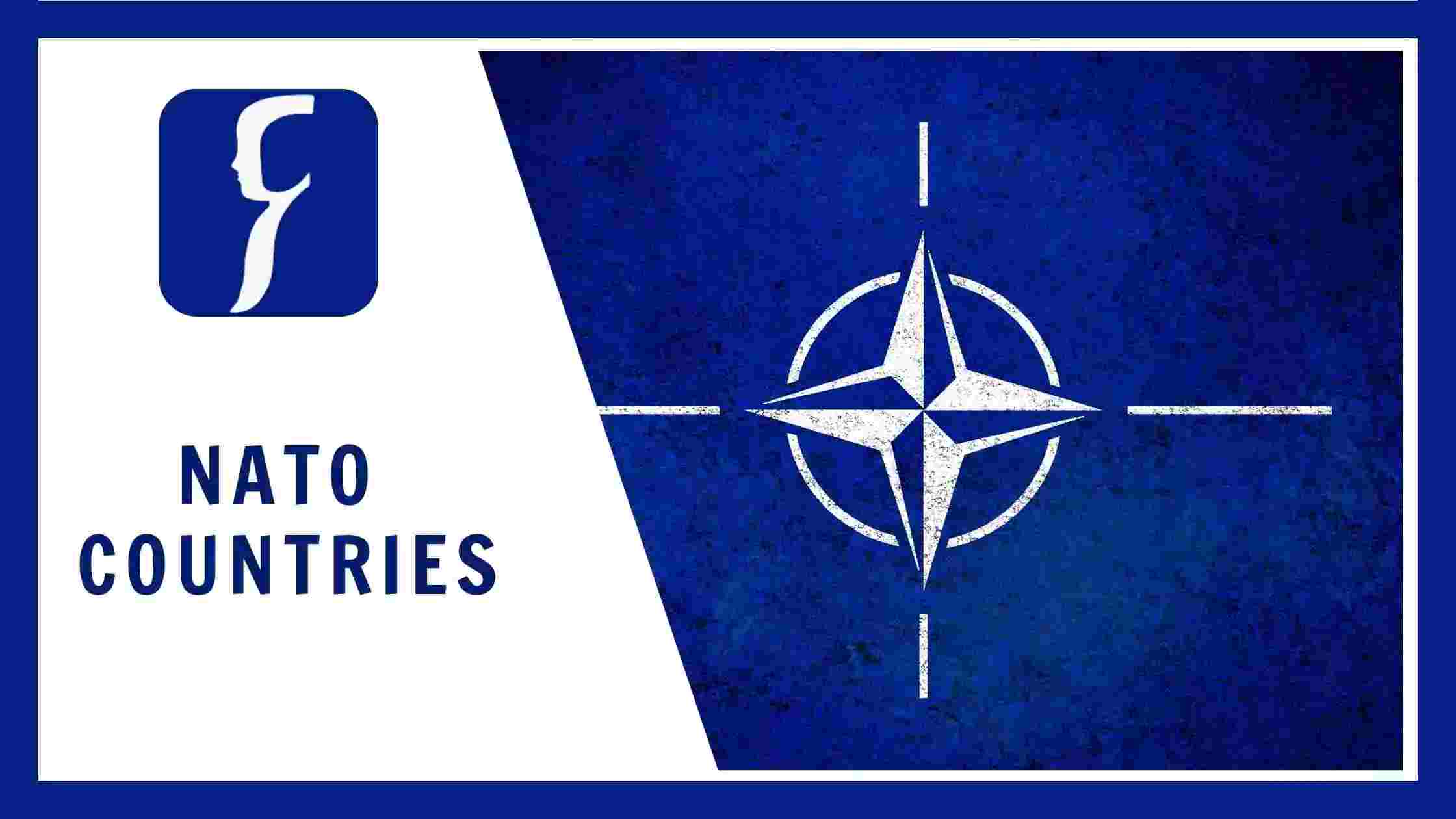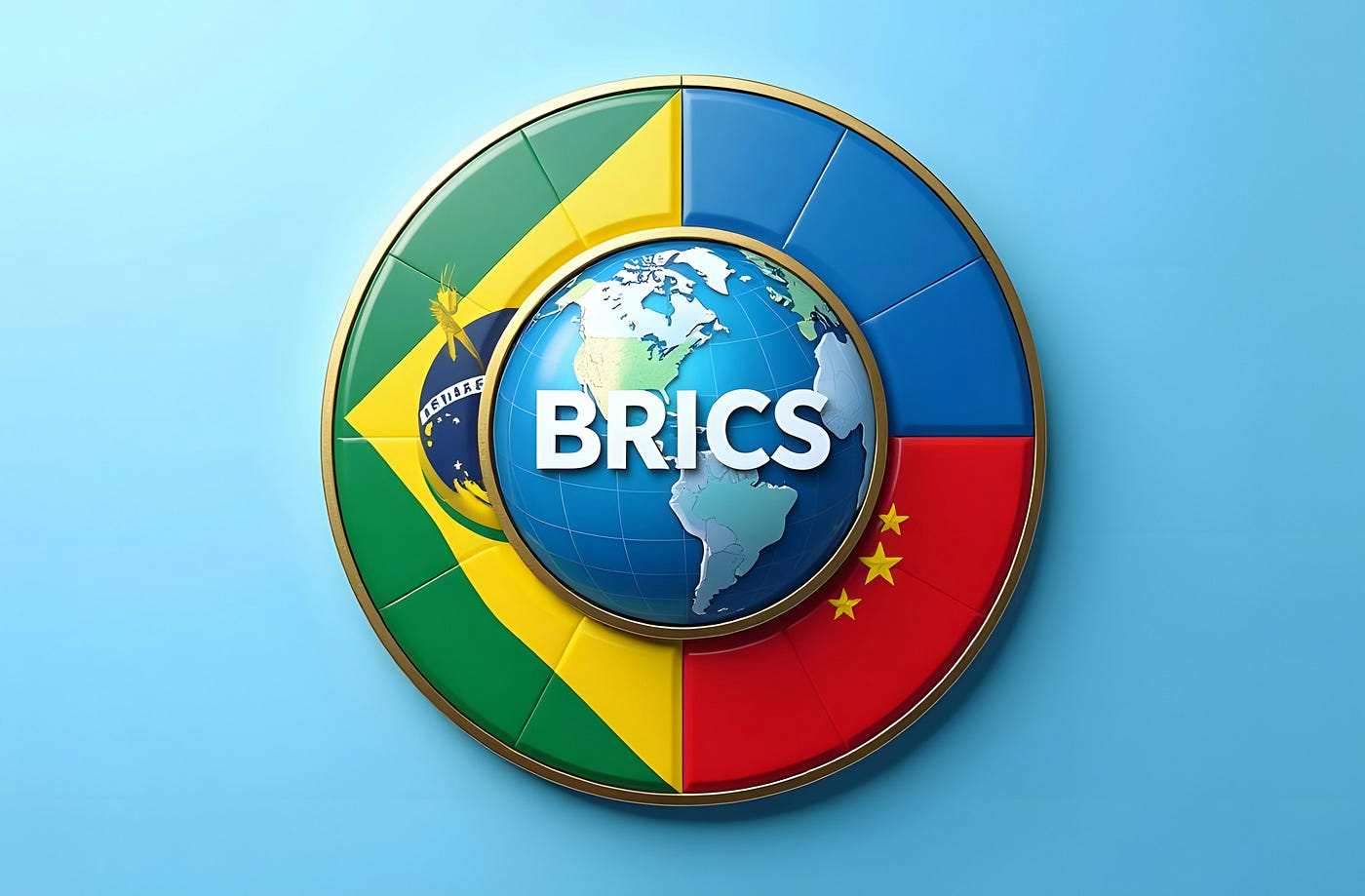NATO and BRICS are two major international groups. NATO (North Atlantic Treaty Organisation) is a military alliance of 32 countries, mostly from North America and Europe.
It was formed in 1949 to protect its members from external threats. Key members include the U.S., Canada, the U.K., France, and Germany.
BRICS, on the other hand, is a group of emerging economies. It originally had five countries—Brazil, Russia, India, China, and South Africa.
In 2024, it expanded to include Egypt, Ethiopia, Iran, Saudi Arabia, and the UAE, making it a 10-member group.
NATO is strong in defence, while BRICS focuses on economic growth. But who is more powerful overall? In this article, we’ll compare them based on military strength, GDP, population, and other key factors. Stay tuned to find out!
Check Out| What is De-Dollarization? Why Trump Warned BRICS Against Ditching the Dollar Explained
NATO vs BRICS: A Quick Overview

Source: Compass by Rau’s IAS
NATO (North Atlantic Treaty Organisation) and BRICS (Brazil, Russia, India, China, and South Africa) represent two distinct geopolitical alliances with different objectives, structures, and influences on the global stage.
NATO: Structure and Purpose
Formation: Established in 1949 as a military alliance primarily for collective defence against potential aggressors, particularly during the Cold War. Membership: Comprises 31 member countries predominantly from North America and Europe, focusing on mutual defence and security cooperation. Economic Power: Collectively, NATO countries have a GDP of approximately $38 trillion, with significant contributions from the United States, Germany, France, and the UK. Military Focus: NATO emphasises military readiness and defence capabilities, spending heavily on military resources to ensure the security of its members.
BRICS: Structure and Objectives

Source: Andrew Woods
Formation: Initially formed as BRIC in 2006, with South Africa joining in 2010 to create BRICS. The group aims to enhance the economic and political influence of emerging economies. Membership: As of 2024, BRICS includes ten countries—Brazil, Russia, India, China, South Africa, Egypt, Ethiopia, Iran, Indonesia, and the UAE—representing a significant portion of the world’s population (around 42.58%) and approximately 22% of global GDP. Economic Focus: Unlike NATO’s military emphasis, BRICS focuses on economic cooperation among its members to promote trade, investment, and development. The bloc seeks to challenge Western dominance in global financial institutions. Demographic Advantage: BRICS nations have younger populations compared to many NATO countries. This demographic trend may lead to faster economic growth as BRICS harnesses its large labour force.
For You| List of BRICS Countries 2025: Name, Summit Details and Chairmanship
Comparative Analysis
Feature
NATO
BRICS
Type
Military Alliance
Economic Cooperation Bloc
Established
1949
2006 (as BRIC), expanded in 2010
Members
31 countries
10 countries
Total GDP
~$38 trillion
~$17 trillion
Population
~900 million
~3 billion
Focus
Collective defence
Economic growth and cooperation
Demographics
Ageing populations
Younger populations
Geopolitical Implications
The emergence of BRICS+ as a counterbalance to NATO reflects shifting global power dynamics.
While NATO remains focused on military alliances and collective security primarily for Western interests, BRICS+ seeks to amplify the voices of emerging economies in international affairs.
This rivalry underscores a transition towards a multipolar world where both blocs vie for influence over global issues such as trade policies and geopolitical strategies.
Military Strength: Who Has the Upper Hand?
When comparing the military strength of NATO and BRICS, several factors come into play, including military expenditures, troop numbers, technological capabilities, and overall strategic objectives.
NATO: Military Overview
Collective Defence: NATO operates under the principle of collective defence as outlined in Article 5 of the North Atlantic Treaty, meaning an attack on one member is considered an attack on all. This has historically provided a strong deterrent against potential aggressors. Military Expenditure: In 2024, NATO members are expected to collectively spend significantly on defence, with many countries aiming to meet or exceed the 2% GDP target established at the Wales Summit in 2014. For example, Poland is projected to spend 4.7% of its GDP on defence in 2024. Troop Readiness: NATO has increased its rapid response capabilities significantly since the onset of the Ukraine conflict. The alliance can now mobilise up to 500,000 troops within a range of timeframes, depending on the threat level. This includes 100,000 Tier 1 forces ready within 10 days. Technological Edge: NATO countries, particularly the United States, maintain advanced military technologies and a diverse array of weapon systems. The alliance’s combined military power index (GFP rating) stands at approximately 3.8900, reflecting its significant conventional military capabilities.
Discover| GK Quiz on BRICS Summit and NATO Countries
BRICS: Military Overview
Diverse Military Capacities: BRICS nations include some significant military powers—most notably Russia and China—which contribute to the bloc’s overall military strength. India also has a substantial military force, while Brazil and South Africa have smaller but capable armed forces. Military Expenditure: The combined military spending of BRICS countries is less than that of NATO but has been increasing as these nations seek to enhance their defence capabilities. While exact figures vary, BRICS nations are generally estimated to spend less than NATO collectively. Strategic Cooperation: BRICS emphasises economic collaboration over military alignment but recognises the importance of defence cooperation among its members. The bloc’s expansion to include new members indicates a growing interest in enhancing collective influence rather than a unified military strategy. Geopolitical Influence: The member states of BRICS represent about 46% of the global GDP and a significant portion of the world population and trade potential. This economic heft can translate into strategic advantages in global power dynamics.
Comparative Analysis
Feature
NATO
BRICS
Military Alliance Type
Collective defense
Economic cooperation
Total Military Expenditure
Higher (over $1 trillion)
Lower (around $400 billion)
Troop Readiness
Up to 500,000 troops mobilizable
Varies by nation; less coordinated
Technological Advantage
Significant (especially U.S.)
Varied; Russia and China have advanced capabilities
Geopolitical Strategy
Focused on deterrence
Emphasizes economic influence
In Case You Missed| BRICS Summit 2024: 16th Edition Key Highlights, Major Outcomes and Relevance
Economic Power: GDP and Trade Comparison
The economic power of NATO and BRICS can be assessed through their Gross Domestic Product (GDP), trade volumes, and overall influence on the global economy.
This comparison highlights the growing significance of BRICS in contrast to the established economic dominance of NATO countries, particularly the G7.
1) GDP Comparison
BRICS GDP: As of 2024, the BRICS bloc, which includes Brazil, Russia, India, China, South Africa, and new members such as Iran, Egypt, Ethiopia, and the UAE, collectively accounts for approximately 37.4% of global GDP. This translates to over $60 trillion in total economic output. The addition of new members has significantly bolstered its economic standing and growth potential. NATO GDP: NATO countries, particularly the G7 members (Canada, France, Germany, Italy, Japan, the UK, and the US), represent about 43% of global GDP. The United States alone contributes a substantial portion, with a GDP projected at around $28 trillion for 2024. The combined economic output of NATO countries is estimated to be over $40 trillion, reflecting their long-standing dominance in the global economy.
2) Trade Dynamics
BRICS Trade: The BRICS nations are increasingly becoming key players in global trade. They are responsible for about 25% of world exports and have been driving significant portions of global economic growth. Their collective growth rate is projected to be around 4%, outpacing that of many developed nations. NATO Trade: The trade relationships within NATO are characterised by strong ties among member states. For instance, the U.S. had a trade deficit with BRICS countries in 2023, importing goods worth nearly $650 billion while exporting about $300 billion to them. This imbalance indicates a reliance on BRICS for various goods, particularly in sectors like machinery and electronics.
3) Comparative Analysis
Feature
BRICS
NATO (G7)
Global GDP Share (2024)
37.4%
43%
Total GDP (Approx.)
Over $60 trillion
Over $40 trillion
Trade Volume with U.S.
Imports: $650 billion; Exports: $300 billion
Strong inter-member trade relations
Export Share
~25% of world exports
Significant but lower than BRICS
Growth Rate (Projected)
~4%
Slower than BRICS
Population and Global Influence
The demographic and global influence of NATO and BRICS can be assessed through their respective populations, economic power, and geopolitical strategies. This comparison highlights the significant differences in population size and the implications for global influence.
Population Overview
NATO: As of 2024, NATO comprises 32 member countries with a combined population of approximately 952.7 million people. This diverse membership includes nations from North America and Europe, contributing to NATO’s collective strength in terms of military and political influence. BRICS: The BRICS bloc, which expanded to include ten countries in 2024 (Brazil, Russia, India, China, South Africa, Egypt, Ethiopia, Iran, Indonesia, and the UAE), has a total population of around 3.3 billion. This represents over 40% of the global population. The large population base provides BRICS with significant demographic advantages in terms of labour force and market potential.
Global Influence
Economic Power: BRICS countries account for approximately 46% of global GDP and are increasingly influential in international trade and commodities markets. The bloc’s economic growth rates are generally higher than those of NATO countries, positioning BRICS as a rising power in the global economy. Geopolitical Strategy: BRICS aims to create an alternative to Western-dominated institutions like the G7 and the World Bank. By expanding its membership and fostering cooperation among emerging economies, BRICS seeks to amplify its voice on global issues such as climate change, trade policies, and security matters. NATO’s Influence: While NATO’s primary focus is military security and defence cooperation among its member states, it also plays a significant role in shaping international norms and policies. The alliance’s collective military capabilities serve as a deterrent against potential aggressors, maintaining stability in key regions.
Comparative Analysis
Feature
NATO
BRICS
Total Population (2024)
~952.7 million
~3.3 billion
Global Population Share
~12%
~40%
Global GDP Share
~43% (G7 focus)
~46%
Economic Growth Rate
Slower than BRICS
Higher growth potential
Geopolitical Strategy
Military alliance
Economic cooperation and influence
You Might Like| 16th BRICS Summit: Expansion, Global Cooperation, and Tatar Cuisine Diplomacy
Who is More Powerful: NATO or BRICS?
Determining which alliance is more powerful—NATO or BRICS—requires a multifaceted analysis of military strength, economic influence, population, and geopolitical strategies.
Both entities operate under different frameworks and have distinct objectives, which complicates direct comparisons.
Military Strength
NATO: NATO is primarily a military alliance consisting of 32 member countries, with a combined military budget exceeding $1 trillion.
This funding supports advanced technologies, extensive military infrastructure, and rapid deployment capabilities.
NATO’s collective defence principle ensures that an attack on one member is treated as an attack on all, providing a strong deterrent against potential aggressors.
The alliance boasts significant military assets, including nuclear capabilities, advanced air forces, and naval strength.
In 2024, NATO can mobilise up to 500,000 troops quickly in response to threats.
BRICS: BRICS is not a military alliance but an economic coalition that includes major emerging economies such as China and Russia.
While these countries have substantial military capabilities, the bloc lacks the unified command structure and collective defence agreements characteristic of NATO.
The military expenditures of BRICS nations are growing but still fall short of NATO’s combined spending.
For instance, Russia and China are modernising their forces and increasing defence budgets, but coordination among BRICS members on military matters is limited due to differing national interests.
Economic Influence
NATO: The economic output of NATO countries (primarily the G7) accounts for about 43% of global GDP.
The United States leads with a GDP of around $28 trillion, significantly contributing to NATO’s overall economic strength.
NATO countries maintain strong trade relationships among themselves and with other regions, reinforcing their economic dominance.
BRICS: As of 2024, BRICS nations account for approximately 46% of global GDP and represent about 55% of the world’s population.
The bloc’s recent expansion has enhanced its economic clout and market potential.
BRICS aims to challenge Western economic dominance by promoting trade among member states and creating alternative financial institutions.
Population Dynamics
NATO: The total population of NATO member countries is around 952 million, which provides a significant consumer base but is dwarfed by BRICS’s demographic advantage.
BRICS: With a combined population exceeding 3.3 billion, BRICS represents over 40% of the global population.
This demographic advantage translates into a larger labour force and market potential, enhancing its influence in global markets.
Geopolitical Strategies
NATO: NATO’s primary focus is on collective security and defence against potential threats, particularly from state actors like Russia.
Its strategic objectives include maintaining stability in Europe and deterring aggression through military readiness.
BRICS: BRICS seeks to provide an alternative to the Western-led order by promoting economic cooperation among emerging economies.
The bloc emphasises collaboration on issues like trade, investment, and development while advocating for greater representation in international institutions.
Conclusion
NATO has the edge in military power with advanced technology, strong alliances, and quick deployment capabilities. Economically, NATO holds great influence, but BRICS is catching up with its growing GDP and large population.
BRICS benefits from a massive population, giving it a strong market and geopolitical presence. While NATO dominates in military strength and readiness, BRICS is expanding its economic reach.
The question of power depends on the context. If it’s about military might, NATO is stronger due to its structured defence alliance. But in economic growth and market potential, BRICS is a rising force.


